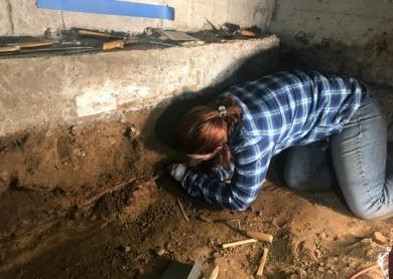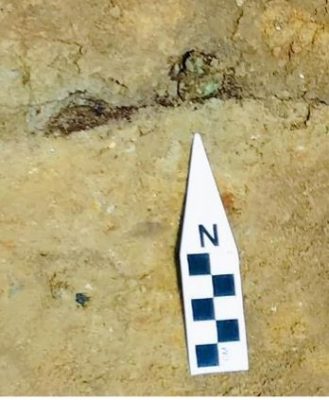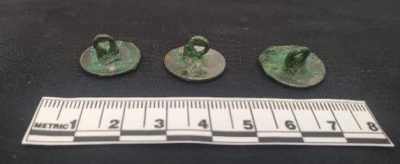Excavation of Ridgefield Burials

Buttons in situ

18th-century Brass buttons

Skeletal Remains Discovered Beneath Ridgefield Home May Belong To Revolutionary Soldiers
by Nick Bellantoni and Scott Brady
Construction activities working to lower the dirt grade under a house basement dating to 1790 uncovered human skeletal remains in Ridgefield, CT. Local police were contacted and reported the discovery to the Office of the Chief State’s Medical Examiner, whose forensic team identified the remains as being historic and not part of a modern criminal investigation. In turn, the state archaeologist was then notified to assume the enquiry. In Connecticut, the state archaeologist has statutory responsibility for investigating human remains that are over 50 years.
Subsequent excavations, assisted by FOSA and ASC members, as well as anthropology graduate students from UConn, have yielded four skeletons of young, robust adult males, four of which were hastily buried together in a common shallow grave where the bodies are commingled with overlapping arms and legs.
The discovered burials are located in the area of the Revolutionary War Battle of Ridgefield (April 27, 1777), which followed British General Tryon’s raid on Danbury where his troops destroyed a Patriot arsenal and burned a number of houses. As Tryon’s companies were marching back to rendezvous with their ships anchored off of Westport, they passed through the Town of Ridgefield, where American Generals Benedict Arnold and Gold Selleck Silliman erected a barricade at a pinch point along the northern part of Ridgefield village to intercept the British advancement. Meanwhile, American General David Wooster’s regiments were harassing the British rear guard when the general was shot and killed prior to the redcoats fighting with Arnold and Silliman’s forces.
The British clashed with the Patriots at the barricade driving the defenders into withdrawal to regroup at the Saugatuck Bridge in Westport in order to mount a new attack. Winning the day, the British encamped overnight in Ridgefield and buried their dead where they lied on the battlefield. Tryon’s report listed 24 British killed and 28 missing. Historians recorded 16 British soldiers and eight Patriots were buried in a small field to the right of the American position on the battlefield, though subsequent research offers varying estimates of the dead.
Our working hypothesis is that the burials found under the basement were victims of this historic battle. Material culture recovered from two individuals includes 38 brass and pewter buttons, which are in the process of being cleaned of corrosion to assist in determining insignias. The Office of State Archaeology will be assisted in the forensic and artifact identifications by in-state universities, including the University of Connecticut, Yale University, Quinnipiac University, as well as Archaeological and Historical Services, Inc., and other laboratories around the country. Further information will be forthcoming as laboratory analyses continue.